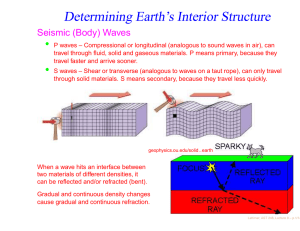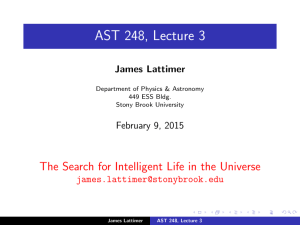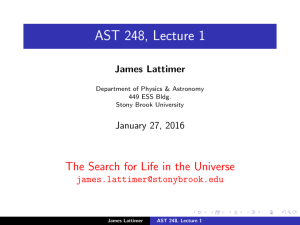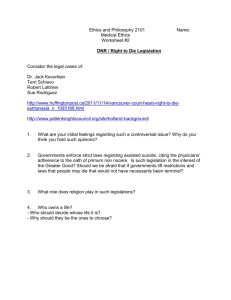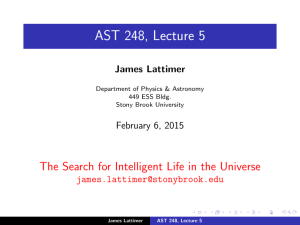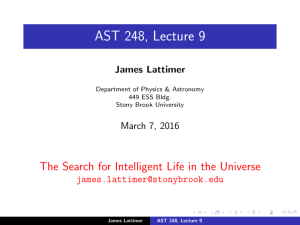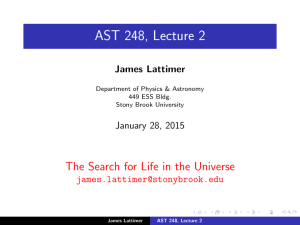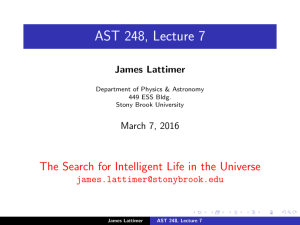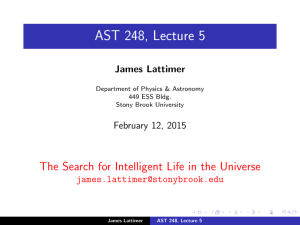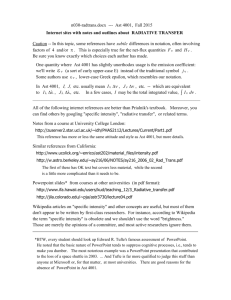www.nineplanets.org
advertisement
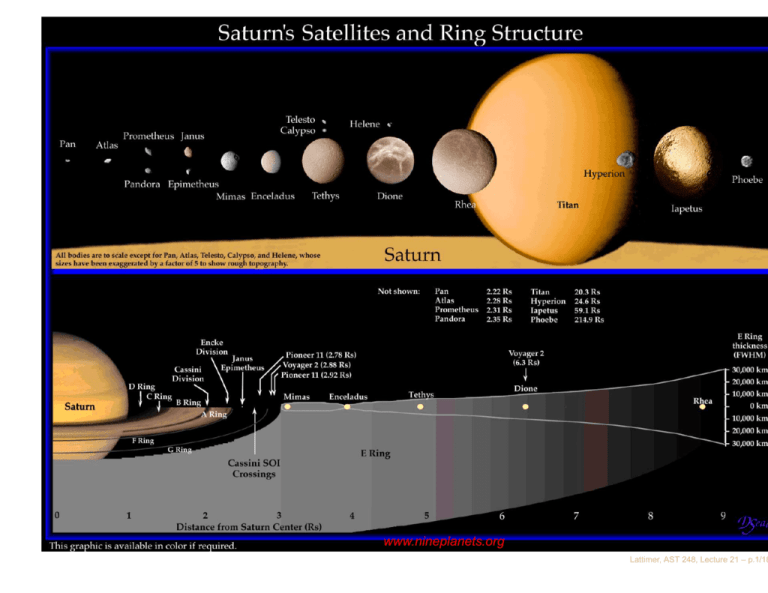
www.nineplanets.org Lattimer, AST 248, Lecture 21 – p.1/18 Titan • • • • • Only moon with dense atmosphere, 1.5× Earth’s • Major gases are N2 (98.4%), CH4 (1.6%), Ar; smog (hydrocarbon, tholin) layer at high altitude. • Lack of noble gases Kr, Xe and Ne suggest atmosphere formed as a result of outgassing rather than by cometary impacts. • Haze results in anti-greenhouse effect: opaque to visibile, clear to infrared. • Methane (CH4 ) is present and must be replenished, indicating volcanos or lakes of methane or ethane (C2 H6 ). • • Cassini probe mapped surface in 2004. • Surface is complex, fluid-processed and geologically young (H2 O and NH3 volcanos?) Saturn’s largest satellite, 2nd in Solar System Spin tidally locked with Saturn In a 3:4 orbital resonance with Hyperion Atmosphere’s existence a result of relatively cold formation temperature and high gravity Surface temperature is 94 K, methane rain may exist Haze Lattimer, AST 248, Lecture 21 – p.2/18 Titan’s Interior Evidence for H2 O-NH3 sub-surface ocean from ELF (extremely long frequency radio waves 3400 km radius rocky core surrounded by several ice layers Ammonia (NH3 ) lowers H2 O freeezing point NASA Systematic shift of surfac implies crust floats on oc Lattimer, AST 248, Lecture 21 – p.3/18 Titan’s Climate Methane rains and ethane snows onto poles in winter and evaporate during summer. Titan’s year is 30 Earth-years long. CH4 NASA Lattimer, AST 248, Lecture 21 – p.4/18 Hydrocarbon lakes Lattimer, AST 248, Lecture 21 – p.5/18 Titan’s Surface NASA Lattimer, AST 248, Lecture 21 – p.6/18 Titan’s Volcanoes and Lakes Cryovolcano Tortula Facula Cryovolcano Sotra Facula Lattimer, AST 248, Lecture 21 – p.7/18 Life on Titan? • Conditions on Titan might be suitable for some terrestrial psychrophiles, which utilize organic chemicals for both food and energy. • Some key elements are liquid reservoirs, organic molecules and energy sources. • Ultraviolet light reacting with nitrogen and methane in atmosphere produces hydrocarbons, visible as orange smog, which fall onto Titan’s surface. • Large organic molecules (tholins) up to 10,000 times the mass of Hydrogen have been found in Titan’s high atmosphere, and are possibly responsible for the haze. • Natural forces, such as shifting continental plates, wind erosion, lakes of ethane and methane, and volcanos, can alter the landscape. • • There may exist hot springs connnected to hydrocarbon reservoirs. • Coldness is a real impediment, however, with surface temperature of −180◦ C which would make chemical reactions sluggish at best. Subsurface temperatures in liquid water layer could be much warmer (−73◦ C). • • Early Titan was warmer, due to increased radioactivity and a warmer Saturn. Possible life could produce energy by mixing acetylene (C2 H2 ), abundant in Titan’s atmosphere, with hydrogen. In the future, as the Sun warms and becomes more luminous, temperatures will increase, reaching −70◦ C when the Sun becomes a red giant. Lattimer, AST 248, Lecture 21 – p.8/18 Enceladus • • • Small size, but geologically active • Presence of low melting-point liquid, not pure water, under surface. • Tidal resonance with Dione or Saturn may be source of heat Surface 90% reflective due to fresh ice Ice volcanos may be the source of Saturn’s E-ring material Lattimer, AST 248, Lecture 21 – p.9/18 Lattimer, AST 248, Lecture 21 – p.10/18 Lattimer, AST 248, Lecture 21 – p.11/18 Saturn’s E ring with Enceladus Tethys Enceladus south polar jets Lattimer, AST 248, Lecture 21 – p.12/18 Lattimer, AST 248, Lecture 21 – p.13/18 Iapetus • Iapetus has leading hemisphere which is dark (carbon-rich) and a trailing hemisphere which is bright (ice). • Dark material may be deposited from matter chipped off Phoebe, a very dark satellite; this matter may also coat Hyperion. Orbit is highly inclined. Equatorial bulge Lattimer, AST 248, Lecture 21 – p.14/18 Phoebe and Hyperion • • Small Saturn satellites • • Phoebe is very dark: albedo is 0.06 Phoebe has retrograde orbit and very rocky, indicating it is a captured Kuiper Belt object. Hyperion is 2nd largest irregular body in solar system; Neptune’s Proteus is larger. Phoebe Hyperion Lattimer, AST 248, Lecture 21 – p.15/18 Mimas • Mimas clears the material from the Cassini Division, the gap between Saturn’s two widest rings, because that location is in a 2:1 orbital resonance with Mimas • Impact that produced the large crater (Herschel) almost completely shattered Mimas; an equivalently-sized crater on the Earth would be as wide as the U.S. Lattimer, AST 248, Lecture 21 – p.16/18 Triton • • Largest satellite of Neptune, third-most massive moon in solar system • Decaying orbit will take Triton within Neptune’s Roche Limit, causing breakup in 3.6 Gyr. • Thin atmosphere of N2 and CH4 • Few craters, active N2 , H2 O, CH4 cryovolcanos and geysers; relatively young surface < 50 million years old • No tidal heating, but seasonal solar heating creates a solid-state (ice) Greenhouse effect; geysers observed are located only near subsolar point. Only large moon with a retrograde orbit, probably originally a binary Kuiper Belt object that was captured and disrupted Lattimer, AST 248, Lecture 21 – p.17/18 Dark streaks of dust left by nitrogen geysers Lattimer, AST 248, Lecture 21 – p.18/18
